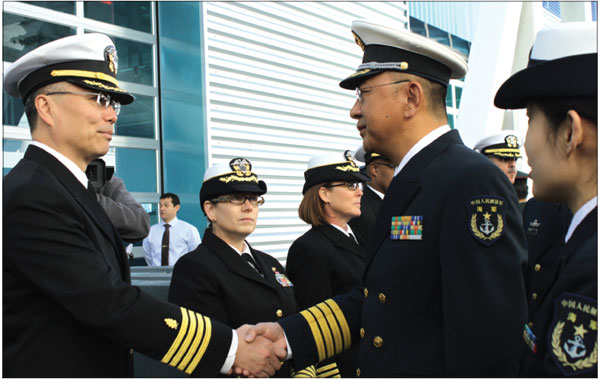Bridging the seas

During his state visit to the US in September, President Xi Jinping said there should be more military exchanges between the two countries. Despite rising tensions between China and the US over the South China Sea, both sides are continuing to do what Xi called for, reports June Chang from San Francisco.
A t 8 am on Nov 3, US Navy Captain Donald Sze stood waiting on the Broadway Pier at the Port of San Diego in California.
On that day, 2,090.27 miles away on the US East Coast at the Mayport Naval Station in Jacksonville, Florida, US Navy Rear Admiral Mary Jackson also was waiting.
For the Beijing-born Sze, the wait was to welcome the Chinese hospital ship Peace Ark, which was arriving for a five-day visit. And for Jackson it was to greet three ships of the Chinese People's Liberation Army (PLA) Navy that would make history when they docked: the first Chinese Navy vessels to pay a call on a US East Coast port. The ships were on an around-the-world tour after completing an anti-piracy mission in the Gulf of Aden.
The ships' visits were in keeping with President Xi Jinping's push for more China-US military collaboration. At his meeting with President Barack Obama on Sept 25 in Washington during his US state visit, Xi said that military-to-military ties are a vital component of China-US relations, and the two sides should maintain the momentum for high-level military exchanges.
He called on the two militaries to make better use of research institutions and academies and conduct more joint drills and training exercises. Xi noted that China, at the invitation of the US, will join the 2016 Rim of the Pacific multilateral naval drills and send personnel to Seattle to participate in humanitarian aid and disaster relief training.
Exchanges increased
Since Xi's visit, both countries have stepped up efforts for more military exchanges despite tensions rising over the South China Sea.
On Oct 12, the training ship Zheng He of the PLA Navy arrived in Peal Harbor, Hawaii, for a four-day training exchange and good-will visit. Since 1987, Zheng He, China's first naval training vessel, has completed a global voyage and has visited 28 countries and regions. The ship's 1989 visit to Pearl Harbor was the first by a PLA vessel to a US port since 1949.
Commander Yan Zhenming of Zheng He said China's Navy personnel need to broaden their knowledge and enhance their professionalism through regular exchange programs with their US counterparts.
For US Navy public affairs officer Krystyna Nowakowski who attended the Hawaii Port reception, it was her second time aboard the Zheng He.
Delighted to see her Chinese culture course teacher from the Chinese navy again, she recalled her first trip on Zheng He in 2013 when the vessel crossed the Atlantic Ocean. "I was a third-year student at the US Naval Academy in Annapolis. I had two Chinese culture courses onboard then and had a great time with (Chinese sailors and officers)," Nowakowski said.
During its Hawaii stay, the Zheng He crew visited the headquarters of the US Navy's Pacific Fleet and the USS Chosin, a Ticonderoga-class guided-missile cruiser named in honor of the Battle of Chosin in the Korean War. The crew gained first-hand experience watching how US Navy sailors conducted various exercises, including search-and-rescue.
On Oct 27, US-China tensions over the South China Sea made global headlines when the US guided-missile destroyer, the USS Lassen, went close to one of Chinese islands. The Chinese government said it had tracked and warned the ship, and called in the US ambassador to protest.
Despite that, both countries have continued to stress military-to-military exchanges and joint exercises.
On Nov 3, when the PLA hospital ship was arriving in San Diego and the three PLA ships were docking in Jacksonville, in Beijing and in Kuala Lumpur, Malaysia, US and Chinese officials tangled face-to-face over the South China Sea, but again showed support for military exchanges.
In Beijing, Admiral Harry Harris, the commander of the United States Pacific Command, met Fan Changlong, vice-chairman of the Central Military Commission. Harris, the Navy's highest-ranking Asian American ever, said during his visit to China that the US would continue to conduct navigation operations in the South China Sea. Fan told Harris to "stop wrongdoings and dangerous moves" in the South China Sea and to avoid "misunderstanding, misjudgment and unpredictable incidents."
Despite the exchanges, Harris told Fan that he hoped to "strengthen the cooperation and communication" between the two nations' militaries and push for a "continuous development" of military relations.
In Kuala Lumpur, China's Minister of National Defense, Chang Wanquan, and his US counterpart, Defense Secretary Ash Carter, met on the sidelines of the Association of Southeast Asian Nations Defense Ministers' Meeting-Plus (ADMM-Plus).
While Carter continued to voice his concern over China's activities in the South China Sea and cyberspace, he also accepted an invitation to visit China next spring, and expressed support for US-China military-to-military relations, saying they can contribute to regional understanding.
Back at the wharf in San Diego on Nov 3, a marching band played the Chinese and American national anthems. Peace Ark task group commander Senior Captain Guan Bailin, his crew and Chinese officials exchanged greetings with their US counterparts.
Led by commanding officer Captain Jose Acosta of the Naval Medical Center-San Diego, the US delegation included Captain Melanie Merrick of the US hospital ship the USNS Mercy, representatives from US military healthcare providers and members of the Chinese-American community.
"We are excited to visit the beautiful city of San Diego," said Guan at a reception on the ship's deck. "This is the fourth stop on the Peace Ark's seven-country voyage. We have already visited Malaysia, Australia and French Polynesia since the ship started its mission on Sept 23."
"The Peace Ark is sailing the Pacific Ocean to advance military diplomacy, medical exchanges and cultural communications with foreign countries," said Guan, adding that his ship had provided free medical and humanitarian services to local residents, Chinese nationals and overseas Chinese along its route.
'Shared bond"
Showing US officers and sailors around the Peace Ark, Guan said the first-ever Chinese hospital ship to visit San Diego was an important part of China-US military exchanges. "The US and China need to maintain regular military exchanges and communications," he said.
The Peace Ark's US counterpart, the USNS Mercy, arranged comprehensive programs for the visiting crew, including hospital ship visits, research collaboration and seminars.
Acosta said he was impressed by the Peace Ark's facilities, equipment and crew. "Medical service providers throughout the world belong to one family regardless of their nationalities," he said. "We are all united by the shared bond of providing safe medical treatment to our patients."
On Nov 4, the Peace Ark crew visited the Naval Medical Center, where Acosta emphasized the need for US-China military exchanges: "We need to better understand each other and learn from best medical practices. I can see only growth in future bilateral exchanges between our military hospitals."
In Florida under a bright blue sky, the three ships of Escort Taskforce 152 - with more than 800 Chinese officers, sailors and special operation troops - was welcomed by US naval officers led by Admiral Mary Jackson, of Commander of Navy Region Southeast, Cui Tiankai, the Chinese ambassador to the US, and members of the local Chinese community.
After greeting the fleet and guests in Chinese - Zaoshang hao (Good Morning) - Jackson said: "The seas are great highways connecting the people of the world. No matter what differences exist between cultures, those who have served at sea share a common bond that can only be fully appreciated by sailors." She said she hoped the fleet's goodwill visit would strengthen that spirit of friendship and understanding.
Senior Captain Wang Jianxun, commanding officer of the fleet and deputy chief of staff of the PLA Navy's South China Sea Fleet, described the visit as elevating cooperation between the two navies from across the Pacific to across the Atlantic.
Li Bo, head of the Jacksonville Chinese Association, said the Chinese community had spent a month preparing to welcome the Chinese fleet with a new dragon dance team. "Chinese Americans hope for more cooperation between China and the US and hope for peaceful co-existence," he said.
Calling the visit an important project between the two militaries this year and an event of great significance, Cui said, "We are very glad to see the exchanges between the two militaries being conducted in a very positive atmosphere."
He said that while China and the US have some differences, it is evident that the common interests and common needs of the two countries on some global issues have been constantly increasing and expanding.
"This is the trend and direction," he said.
Chen Weihua contributed to this story.
Contact the writer at junechang@chinadailyusa.com
| |

| |
(China Daily 11/13/2015 page20)
Today's Top News
- Xi congratulates Jennifer Simons on election as Surinamese president
- Australian PM's visit aims to boost cooperation amid global challenges
- China says response to Japanese planes' actions reasonable, professional
- Wang calls Rubio meeting constructive
- Tianzhou 9 cargo craft transported to launch site
- Gaokao not only way to be successful in life
































